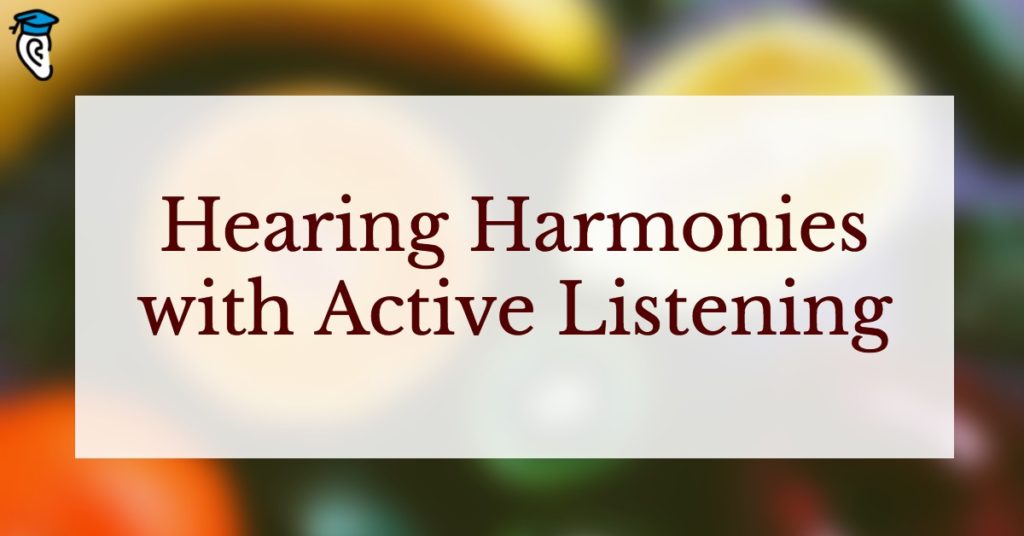When we listen to a song, our first instinct is to listen first to the melody and the lyrics. Have you ever tried focusing on the harmony of a song, instead? Learning to hear the harmonies has many benefits for all musicians whether interested in singing in a choir, composing an interesting piece of music or just strengthening your ear training skills.
This is a summary post.
→ Read the full guide
The value of active listening
Here at Easy Ear Training, we strongly believe in the benefits of active listening. So what does it mean to “actively listen” to a song?
It means paying attention to the music you’re hearing, and actively trying to analyze it in your head while you listen. Challenge yourself to truly listen to music in a new way – or to new music altogether. After all, the more you listen – and not just “hear” – the more you learn!
To hear harmony, first find the melody
To identify the harmony from the melody, you must already know how to hear melody. What is the difference between melody and harmony?
Melody is the principal part of harmonized (or unharmonized) music. It’s the part we identify first because it’s usually attached to the lyrics and easily identifiable.
Harmony, on the other hand, supports the melody. It’s what gives the music texture, mood and interest by the use of simultaneous pitches or chords, but it may not immediately stick out to our ears as quickly as the melody does.
Hearing harmony helps you as a singer
If you are a singer, learning to hear the harmony is an integral part of your craft. Even if your goal is to only sing melody, it helps to know how to clearly hear the other parts.
If you wish to sing in a choir or mixed-voice group, learning to identify the harmony will provide you the option of singing multiple parts.
In jazz improvisation, knowing the harmonic structure of a song will make a difference in your ability to find interesting notes to sing in your vocal line.
Most singers will have experience with ear training of some sort, usually with the solfa system. Now is a good time to use that training! Listening for the harmony is a great way to practice solfa and relative pitch.
Hearing harmony helps you as a composer
Composers know the value of creating mood in music and one great way to accomplish this is through the use of harmony.
If you learn to hear to the harmonies of other songs, it can provide you with ideas to help make a simple melodic line better.
The more you listen to harmony, the more you can move away from what you’d assumed were the “right and wrong” notes in music, giving you the freedom to experiment with more complex sounds.
Speaking of complexities: the more you listen for harmonies, the more you will appreciate the true complexity and beauty of the music you hear each day!
Ways to listen for harmony
To begin listening for the harmony, start by identifying the different textures, timbres and colors of the music. This is most easily done by identifying the different voices and instruments in the song.
If you are good at solfa and relative pitch, try applying them to help identify the harmony. If you play and instrument now is the time to play along! This is another tool in your kit to help find the harmony.
Ask yourself some questions as you actively listen: Is the harmony above or below the melody? Do the melody and harmony parts actually overlap or interchange during the song?
Where to listen for harmony
Although there are clearly many forms and genres of music where you can listen for harmony, let’s focus on vocal music.
Start by listening to songs with two or maybe three voices. Pop songs with a refrain of distinctive voices are a good place to start, such as songs by Toto, the Eurythmics and The Mamas and the Papas.
Once you’ve been able to identify the harmony in two- and three-voiced music, have a listen to four-voice a cappella music, such as good old fashioned barbershop quartets or choral music. For five voices, the popular group Pentatonix is a good way to try and hear all five parts.
Actively listening to harmony can only enhance your musical experience. Who knows, you may even find the challenge to be fun! As with anything in music, the more you do it, the easier it will become. All you have to do to learn to hear harmonies is listen to the music – all the time.







